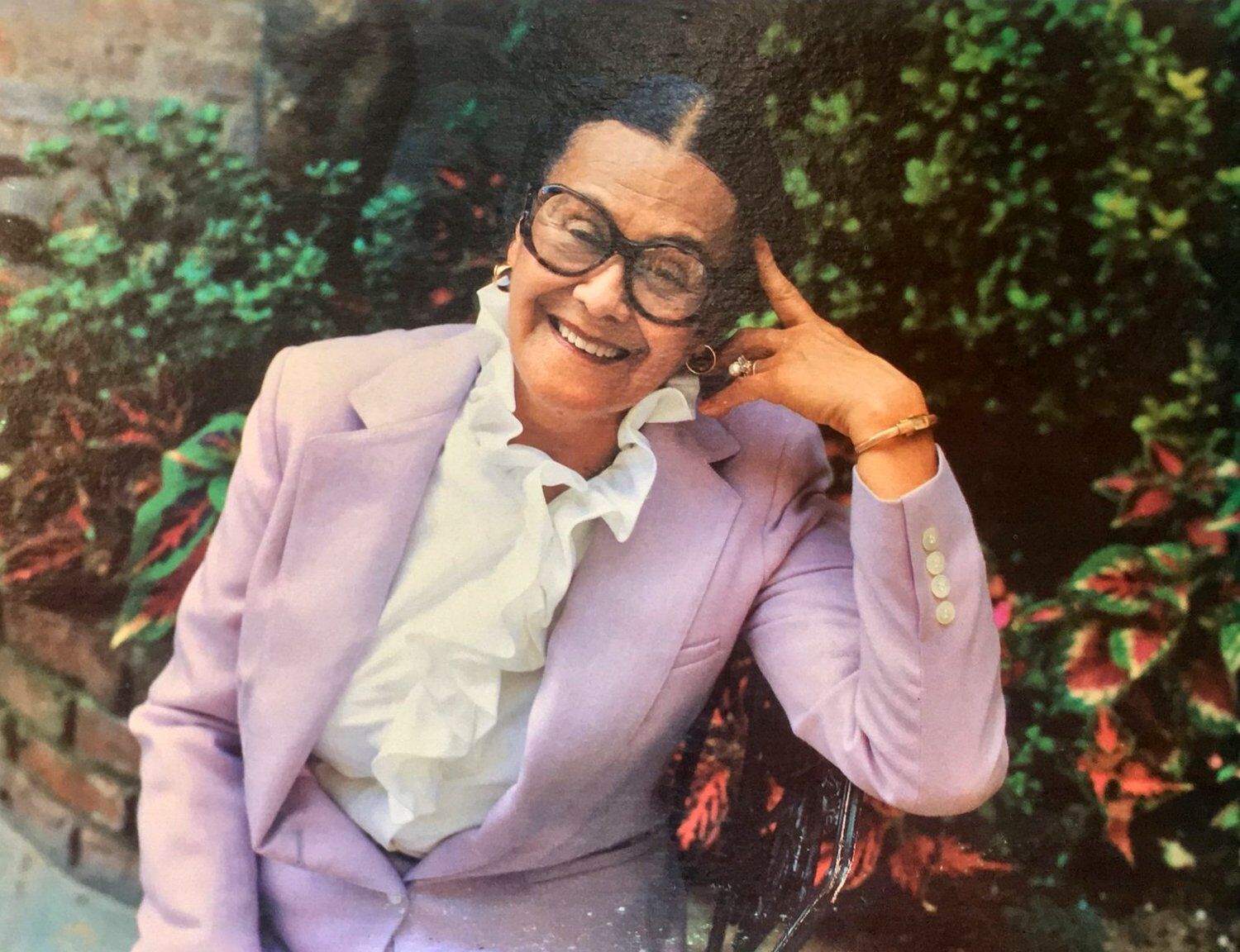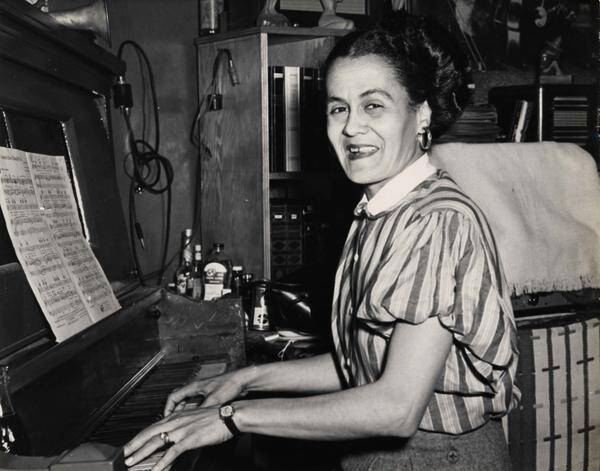If there’s one thing my Sherrie Tucker-inspired scribblings—to which I collectively refer as “my forgotten ladies”—have revealed, it’s that behind many of history’s greatest jazzmen sat an underappreciated woman equipped with formal training in music theory and an unmatched sight reading ability. These women held bands together from the piano stool, allowing their relatively uneducated male bandleaders to improvise up a storm.
Far too often, these lady linchpins of male-fronted jazz bands never became famous in their own right. Sometimes they resigned from their musical careers to raise families—occasionally they were forced to do so by uncompromising husbands (see Dolly Adams for an example of this musical misogyny).
Only a minority of female former accompanists would go on to lead their own outfits, with fewer of these becoming household names, even amongst jazz fans—Lil Hardin is the only example which springs to mind. (One might include Mary Lou Williams and Una Mae Carlisle, but they began their careers as soloists—and Carlisle was arguably as famous for her voice as for her playing.)
Jeanette Kimball’s name has proved less enduring in the jazz canon even though her skill at the keyboard and contribution make her no less worthy. For the following summary I am once again indebted to Sherrie Tucker and her fascinating thesis A Feminist Perspective on New Orleans Jazz Women, as well as various other memoirs, obituaries, blogs, et cetera.
Born Jeanette Salvant on December 18, 1908, her mother Susie was a cook and her father June a carpenter. The family lived in Pass Christian, MS, and included Jeanette’s older sister Octavia as well as her two younger brothers Julius and Gaines. All had musical interests, but only Jeanette would pursue these to their ultimate professional ends as a performer and recording artist.
Exposed to music through the family’s Catholic church and the carefully curated selection of records which her parents allowed in the house, Jeanette showed an early talent for music when she would mess around on pianos owned by friends of her family. Susie arranged piano lessons with Anna Stewart, a conservatory-educated classical pianist, which Jeanette took three times weekly at a rate of 50¢ a week.
Stewart imbued her eager young student with the mastery of melody, harmony, and transposition which would make her an indispensable part of several leading jazz bands of the day—before she finally branched out on her own. But she would cut her teeth in a string band featuring mandolin player Harry Watson, guitarist Eddie Watson, and banjoist Henry Watson (brothers, presumably), which was resident at a hotel called Inn By The Sea.

Pass Christian in the early twentieth century often hosted jazz bands making their way along the Gulf Coast to New Orleans, which lay less than a hundred miles to the west. Jeanette’s strict parents would never allow her to go dancing, but she would watch the bands of Kid Rena and Papa Celestin ballyhoo through the town, advertising their presence by playing from the backs of flatbed trucks. And while these trucks seldom featured a pianist (and therefore seldom bore any women), they still inspired Jeanette to reach for the stars.
In 1925, Celestin stopped long enough in Pass Christian to audition for a new pianist, having lost Emma Barrett to trombonist William “Bebe” Ridgley. Jeanette must have been dumbfounded when Celestin and his sax man Paul Barnes dropped in on the Salvant household, having heard about Jeanette’s prodigious talent. Tested with a series of orchestral arrangements, Jeanette was able to play whatever Celestin put in front of her. Future collaborator Clive Wilson reported in his memoirs that Barnes exclaimed to Celestin, “Why, Papa, I believe she can play better than us!”
And so she was allowed to leave for New Orleans with the band—with a promise to Susie from its leader that the recent high school graduate would be well looked after. From 1926 to 1929, Jeanette recorded with Celestin’s Tuxedo Jazz Orchestra as well as joining them for high society gigs at hotels, carnival balls and on paddle steamers. Celestin eventually recruited a larger line-up, playing special arrangements by saxophonist Cecil Thornton which proved an exciting challenge for the pianist. By 1930 Celestin’s band was touring Mississippi with new banjoist Narvin Kimball, whom Jeanette married in 1929.
One of Jeanette’s most impressive talents, later recalled by her husband, was that she could transpose any piece on the fly to compensate for a poorly tuned piano. The pianist continued playing professionally until 1935, when she resigned from her full-time role in Celestin’s outfit to raise her daughters Barbara and Evangeline. But she continued taking gigs whenever she could, as well as studying and teaching music. (She taught her first music lesson aged 11.)

After a stint as a church organist, Jeanette returned to jazz in 1946 with a gig led by Buddy Charles at the Dew Drop Inn. For four years from 1949 she played with Herbert Leary’s dance band, a gig which suited the mum-of-two as she was not required to tour. Then, in 1953—after 19 years away from Celestin’s orchestra—Jeanette resumed her place at its piano stool, where she sat when the band played for President Eisenhower at the White House.
Her marriage to Narvin did not last: “I was staying with my aunt [in New Orleans, during the early 1950s]. Then Narvin began all that foolishness,” she told Wilson. An old childhood sweetheart heard about the divorce and called to say he was driving down from Atlanta to comfort her. “I was so excited,” Jeanette later admitted to Wilson. “But you know what happened? On the way down he was killed in an automobile accident.” Jeanette was depressed “for a long, long time”—it was wisecracking Celestin trumpeter Albert Walters who finally snapped her out of it. “He was always cracking jokes and telling stories,” Jeanette told Wilson. “One day I laughed so hard and it [the depression] was over.”
After Celestin died in 1954, Jeanette continued touring with his ghost band led by Eddie Pierson and then Albert “Papa” French. Their international engagements together included the West Indies, Germany, France, Belgium, Denmark, Sweden, Switzerland, and Finland. In great demand throughout the 1970s, Jeanette was a regular player at Preservation Hall with both Kid Sheik and British expatriate Wilson’s Original Camilla Jazz Band.
Finally, in 1980, Kimball got the opportunity to record an album under her own name, producing Sophisticated Lady with colleagues from Wilson’s outfit. She retired to Ohio and then South Carolina during the 1990s, when health issues made continued performances difficult. In 1998 her contribution to the idiom was recognized with a Black Men of Labor Jazz Legacy Award.
Jeanette Kimball died on March 29, 2001, aged 94. Her sendoff was a traditional New Orleans jazz funeral, as witnessed by anthropologist Helen A. Regis and recalled in Southern Heritage on Display. “I saw a group of brass band musicians, dressed in the traditional black and white jazz funeral uniform… in front of St. Augustine’s Church on St. Claude Avenue,” she wrote. “I recognized Benny Jones, the leader of the Treme Brass Band, and several members of the Black Men of Labor dressed in black suits and shirts of a lovely green and yellow African print I remembered from last year’s anniversary parade.”
Wilson dedicated several pages of his autobiography Time of My Life: A Jazz Journey from London to New Orleans to Jeanette, calling her “the most engaging and rhythmic” pianist he had ever worked with. “Her piano playing had a wonderful swing and an instantly recognizable syncopated two-beat,” said Wilson—despite her ability to draw on and incorporate numerous styles.
In this way, the piano prodigy’s playing was the very embodiment of jazz, Wilson argued. “Jeanette’s repertoire and musical philosophy reflected the ability of New Orleans music to absorb influences and styles from seemingly any direction,” he wrote, quoting Jeanette—with whom he became close friends—herself: “I didn’t want to copy any particular style. I just liked music. It was part of me and it was my talent.”
Dave Doyle is a swing dancer, dance teacher, and journalist based in Gloucestershire, England. Write him at davedoylecomms@gmail.com. Find him on Twitter @DaveDoyleComms.






















